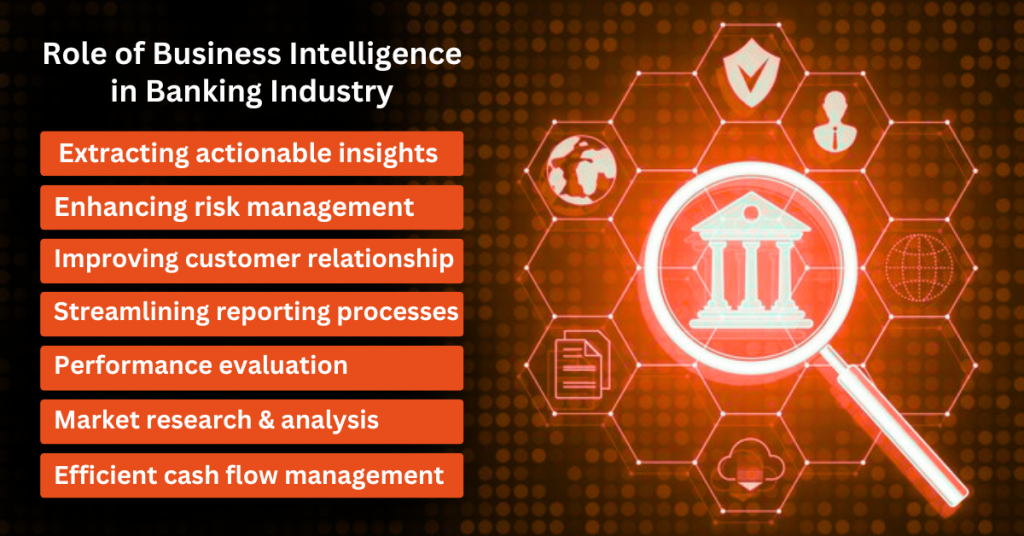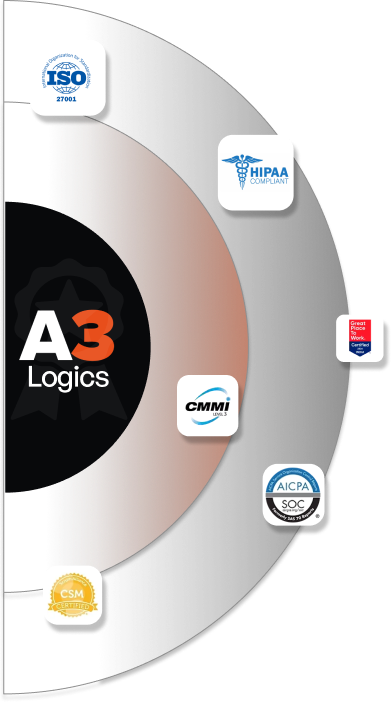| Summary of Business Intelligence in Banking Business Intelligence (BI) is rapidly transforming the way modern banks operate. As one of the most data-driven industries, banking is leveraging BI to unlock insights, drive growth, and enhance customer experiences. With the global banking sector projected to reach a valuation of $55.25 billion by 2034, it’s clear that data-driven strategies will be at the core of this evolution. In this blog, we explore the critical role of BI in banking sector—highlighting the role of business intelligence in banking, its key benefits, real-world applications, and how it’s shaping the future of banking. |
For businesses looking to prosper in a data-driven environment – business intelligence has emerged as a key tool. Businesses may – improve operations and make well-informed decisions. They can obtain a competitive edge in their particular sectors with the help of – BI tools and methods. Furthermore, as BI develops further, new data highlights its increasing significance and revolutionary influence.

Business Intelligence in banking is increasingly transforming the way banks and financial institutions function. As technology progresses – big data analysis and artificial intelligence are becoming increasingly important components of modern banking and finance operations.
It is allowing institutions to get deeper insights into client needs and make decisions that improve their bottom line. Firms are now able to correctly predict and analyze market shifts. Facilitating them to detect trends that can affect their business strategies. They can also streamline operations based on data analysis.
Additionally, machine learning algorithms are being used to identify trends in customer behavior and market movements more quickly than ever before, supporting real-time decision-making that can be used as a source of competitive advantage. This improved knowledge of client requirements also enables financial institutions to deliver more customized products and services.
They are more accurate, leading to greater customer satisfaction. In this blog we have looked at the significance of Business Intelligence in banking.
Table of Contents
Understanding Business Intelligence
Business intelligence is an automated data analysis process. BI allows – leaders, managers, and employees to make informed business decisions. Through the BI process, relevant data is collected and readied for analysis. Queries are run against the data, and the analytics results are utilized to support operational decision-making and strategic planning.
The final goal of BI projects is to aid more informed business decisions. BI enables companies to – create revenue, enhance operational effectiveness, and establish a competitive edge over rivals. The Business Intelligence industry is predicted to grow by 9.1% compound annual growth rate (CAGR) from its valuation in 2023 at $29.42 billion to $54.27 billion through 2030.

To reach this purpose, BI combines analytics, data visualization, and reporting technologies, as well as numerous data management and analysis approaches.
Business Intelligence (BI) is very different from conventional reporting because it provides real-time, interactive, and visually enabled insights that enable the users to make informed decisions in a timely manner. In contrast to conventional reporting, which is based on static – scheduled reports developed by IT organizations BI platforms offer self-service analytics, dynamic dashboards, and drill-downs. This enables users to navigate data on their own, discover trends, and react to changes ahead of time.
BI also aggregates data from various sources to present a complete picture of business operations. Furthermore, sophisticated functions like predictive analytics, integration with AI, and automated reporting differentiate BI from the time-consuming, manual nature of conventional reporting systems.
Role of Business Intelligence in Banking Industry

Business Intelligence in banking is being utilized to uncover patterns between customer actions and market developments faster than ever before, enabling real-time decision-making that can provide a competitive advantage. This enhanced understanding of client needs also allows financial institutions to provide more personalized products and services with more precision, resulting in higher customer satisfaction.
As these new technologies continue to expand, here are the key roles of Business Intelligence in banking.
1. Extract Actionable Insights
Business Intelligence in banking is a technology-driven method. It plays a important role in analyzing and presenting data that enables firms to make informed business decisions. BI in banking sector entails – thoroughly analyzing large amounts of financial data in order to extract insights, find patterns, and forecast market moves.
2. Risk Management
Risk assessment and mitigation are the cornerstones of deploying BI in banking sector and financial institutions. These entities examine data on client interactions, market dynamics, and economic indicators to assess potential risks. The timely identification of risky investments or debtors enables them to make sensible decisions, reduce losses, and protect their assets.
3. Customer Relationship Enhancement
Improving client interactions is the most crucial factor for banks and financial organizations. They use banking analytics solutions to examine consumer data such as transaction history, account balances, and preferences. This data-driven strategy allows them to adjust their services and marketing initiatives, resulting in a better client experience and increased loyalty.
4. Reporting Management
Business intelligence in banking business includes interactive dashboards and charts, allowing organizations to leverage advanced data visualization capabilities. These graphic representations make complex financial data easier to understand. With effective and accurate reports, decision-makers may rapidly discover trends, deviations, and important performance indicators, allowing for faster and more effective decision-making. It also helps the finance department identify and correct errors faster, allowing for data-driven decision-making.
5. Performance Evaluation
Business Intelligence in Banking provides complete performance reviews of financial goods and services. These enable banks to monitor KPIs such as loan approval rates, investment returns, and customer happiness. This data-driven analysis enables banks to better evaluate the performance of their products and identify underperforming ones in order to optimize their offerings and increase profitability.
6. Market Research and Competitive Analysis
BI tools for banks are used to gather information from many sources. This data is then used to do market research, generate market intelligence, and analyze competitors. BI tools for banks are also used to analyze data and find trends, patterns, and important insights through reports and visualizations to better understand the market landscape. This useful understanding influences product development and strategic decision-making. A thorough understanding of market trends and competitor strategies allows you to remain competitive.
7. Efficient Cash Flow Management
BI assists in finding areas critical for cost reductions. This enables banks to streamline processes and optimize resource allocation, boosting profitability while maintaining service quality. When there are financial gaps or excessive spending, it can be difficult to swiftly identify core reasons and the appropriate response. Business Intelligence in banking, on the other hand, make it simple to deal with such scenarios because they automate real-time expense tracking and provide financial control to banks and financial institutions.

Business Intelligence in Banking – Key Use Cases
Banking analytics solutions have grown in popularity as banks seek to use their data to improve customer experiences. To provide a better understanding and overview, let us look at some common applications of BI implementation in banks and how it promotes customer-centric initiatives, enables prudent risk management, and ultimately adds to the industry’s overall performance. BI solutions have grown in popularity as banks seek to use their data to improve customer experiences.
To provide a better understanding and overview, let us look at some key use cases of BI in banking sector and how it promotes customer-centric initiatives, enables prudent risk management, and ultimately adds to the industry’s overall performance.
1. Customer Segmentation and Personalization
BI technology breaks down customer behavior, demographics, and purchase patterns to craft sophisticated segments. Banks can make tailored offers, services, and communications, as well as promote increased customer satisfaction and cross-sell and up-sell opportunities.
2. Fraud Detection and Prevention
Business Intelligence in banking is able to provide real-time detection of unusual patterns or anomalies, enabling banks to detect potential fraud. With machine learning models integrated, BI makes proactive fraud detection stronger, safeguarding banks and customers from financial crimes.
3. Credit Risk Assessment
BI assists banks in assessing the creditworthiness of a borrower by analyzing historical data, repayment patterns, and external economic conditions. Proper risk assessment translates to improved lending decisions, minimized defaults, and portfolio management improvement.
4. Real-Time Financial Reporting
BI dashboards provide up-to-date visibility into financial metrics, equipping decision-makers with real-time insight. This aids banks in monitoring performance, properly managing assets and liabilities, and responding quickly to dynamic market scenarios.
5. Customer Loyalty and Retention Programs
By examining customer opinions, activities, and attrition metrics, BI in banking sector allows them to create precise loyalty programs and forward-looking retention campaigns, ultimately boosting customer lifetime value and diminishing attrition ratios.
6. Regulatory Compliance and Audit Reporting
Business Intelligence in banking streamlines the regulatory data compilation process by automating compliance reports and avoiding errors. BI also facilitates internal audits by ensuring traceable real-time access to all the applicable financial records.
7. ATM and Branch Network Optimization
BI applications review usage information, customer traffic, and volume of transactions in order to enable banks to optimize ATM locations and branch offices. This provides better service delivery and reduces operational expense and wastage of resources.
8. Modernizing Legacy Systems with BI
Business Intelligence platforms connect to legacy core banking systems to transform data access and analysis. This enhances operational effectiveness, supports digital transformation, and enables banks to stay competitive in a rapidly changing environment.
Business Intelligence in Banking Sector – Benefits
The banking industry is not an exception to the many advantages and benefits of business intelligence for banks. BI solutions are now crucial for turning raw data into actionable insights due to the growing volume and complexity of financial data. For banking professionals, BI is more than just reporting; it enables businesses to improve client experiences, make data-driven choices, streamline processes, and reduce risks.
BI is a strategic tool that promotes innovation, efficiency, and competitiveness in the banking sector, helping with anything from real-time financial performance tracking to fraud detection, regulatory compliance, and trend forecasting.
In this section we have taken a look at the various benefits of business intelligence for banks.
> Data-Driven Decision-Making
BI enables banks to make smart decisions through precise, up-to-date data. Executives can make sense of trends, track KPIs, and link strategic objectives with data-driven insights, which will result in appropriate responses to market shifts and client demand.
> Improved Customer Service and Satisfaction
By studying the behavior and patterns of customers, BI in banking sector helps in making their services personalized, reducing response times, and delivering customized solutions. This leads to increased customer satisfaction, loyalty, and overall improved experiences on both digital and physical platforms.
> Enhanced Risk Mitigation
BI systems evaluate risk exposure through examination of credit histories, market trends, and abnormalities in transactions. With BI implementation in banks they are now able to identify likely risks, such as loan default or market fluctuations, and control them proactively, maintaining financial stability and regulatory adherence.
> Improved Operational Efficiency
BI eliminates routine operations, simplifies procedures, and identifies performance roadblocks. Banks enjoy quicker delivery of services, lower error rates, and better allocation of resources, resulting in increased productivity and reduced operating costs.
> Simplified Compliance and Reporting
With BI implementation in banks, can produce timely and accurate reports to comply with regulations. Automated reporting enhances transparency, minimizes errors, and guarantees compliance with standards such as Basel III, GDPR, and other sector-specific compliance models.
> Early Fraud Detection
Real-time data is tracked by BI systems to identify suspicious patterns and avert fraud. By recognizing anomalies in behavior or transactions, banks can respond quickly to save assets and safeguard customer confidence.
> Cost Optimization
BI exposes inefficiencies throughout departments, enabling banks to trim unnecessary costs. Whether optimizing branch operations or improving marketing campaigns, data-driven analysis results in smarter spending and enhanced financial performance.
> Strategic Forecasting and Planning
BI applications examine past and present data to predict trends and plan for future requirements. This aids long-term planning, budgeting, and investment, allowing banks to react to changing financial landscapes.
> Gaining a Competitive Edge
Banks using BI have the ability to innovate quicker, react to changing markets, and provide better customer experiences. Access to rich insights puts them at a competitive advantage in product development, customer engagement, and total market responsiveness.
Challenges – BI in Banking
The application of business intelligence (BI) is bringing about a fundamental shift in the manner in which financial institutions make decisions, manage risks, and deliver services.
However, there are BI challenges in banking that can be faced while turning it into reality in the banking sector. It is possible that the utilization of business intelligence tools by financial institutions could be held down or made more difficult by a variety of specific constraints.
In order to fully exploit the promise of business intelligence (BI), these constraints need to be overcome. These BI challenges in banking include managing outdated infrastructure and ensuring compliance with severe privacy laws must be resolved.
1. Ensuring Data Security and Privacy Compliance: Because they manage so much sensitive data, banks are often the focus of cyberattacks. Implementing BI becomes more challenging when rules like GDPR, HIPAA, and PCI-DSS must be followed.
2. Integration with Legacy Systems: Many banks continue to use antiquated core systems. High technical overhead, performance problems, and data silos might result from integrating contemporary BI solutions with these ancient technologies.
3. High Implementation Costs: Implementing a complete BI infrastructure requires a large financial outlay for personnel, technology, and tools. The upfront expenses might be a big turnoff for many banks, particularly smaller ones.
4. Talent Shortage in Data Analytics: The demand for qualified experts who can handle, decipher, and act upon BI insights is rising. Regretfully, there is a lack of qualified data scientists and BI analysts in the banking sector.
5. Ensuring Data Quality and Accuracy: The quality of the data that BI systems process determines how effective they are. Data that is inconsistent, out-of-date, or inaccurate can result in bad decisions, misleading insights, and regulatory issues.
6. Historical Data Migration: Banks frequently keep decades’ worth of data in various systems. It is a difficult and resource-intensive operation to transfer this historical data into modern BI platforms while maintaining structure, relevance, and security.
Best Practices for Successful BI in Banking

In order to successfully implement BI into banking there are a certain set of practices that help in the flawless execution of BI in banking sector. In the section below we have mentioned some of the best practices for successful BI implementation in banks.
1. Having Clear BI Objectives and KPIs
Having clear objectives and key performance indicators (KPIs) is the basis of successful BI adoption. Banks need to correlate BI initiatives with strategic objectives—be it customer retention, fraud detection, or process simplification. Properly defined KPIs assist in tracking progress, assessing success, and ensuring that all insights produced have a specific business goal behind them.
2. Choosing Appropriate BI Tools and Platforms
Selecting the best-fitting BI tools for banks is paramount to realizing intended outcomes. Banks must evaluate platforms on the basis of scalability, integration ease, user experience, and sophisticated features such as real-time analytics. Consideration of vendor support, security measures, and customization options guarantees that chosen tools meet existing as well as future banking requirements.
3. Investing in Strong Data Integration and Cloud Infrastructure
An integrated perspective of data among departments is a must to deliver correct insights. Banks can spend on credible data integration tools that bring data together from several systems. Cloud-based BI platforms can help to boost scalability, cut infrastructure expense, and allow access to data in real time with support for complex analytics and teamwork.
4. Utilizing AI and Machine Learning for Complex Analytics
Integrating AI and ML with BI systems enables banks to shift from descriptive analytics towards predictive and prescriptive information. More than 70% of businesses will use AI-powered real-time analytics for decision-making by 2025, compared to 40% in 2020. AI and ML enable anomaly detection, market trend forecasting, and personalized customer experiences. Through automation and smart algorithms, banks can make quicker, fact-based decisions and stay competitive amidst a changing environment.
5. Data Governance and Regulatory Compliance
Adherence to regulations such as GDPR, HIPAA, and country-specific banking regulations is mandatory. Effective data governance makes data safe, correct, and ethically handled. The application of strict access controls, audit trails, and data encryption secures sensitive data and establishes trust among customers, regulators, and stakeholders.
6. Training Teams and Enabling a Data-Driven Culture
An effective BI strategy is half people and half technology. Banks must invest in training programs to develop employees’ skills in BI tools and interpretation of data. Building a culture in which data takes center stage in decision-making translates into more effective collaboration, more innovation, and more enlightened leadership throughout the organization.

Future Trends of Business Intelligence in Banking
The future of business intelligence in banking has a very high potential. The users are looking for streamlined processes to provide a smooth banking experience, and as a result, we are witnessing a tremendous increase in the need for more intelligent banking operations and solutions. Taking a look at the many future trends of business intelligence in banking is something that we should do.
1. Financial Analytics through Artificial Intelligence
Artificial Intelligence is transforming BI with the capability of banks to scrutinize humongous amounts of data in real-time. AI algorithms discover trends, predict financial results, and simplify advanced analysis tasks. This allows banking organizations to provide wiser financial solutions, support improved decision-making, and adapt to market movements more quickly and surely.
2. Cloud-Based Scalable BI Solutions
Cloud BI platforms are essential in changing the way banking is done, providing flexibility, scalability, and cost savings. Solutions enable real-time access to data, promote cross-departmental collaboration, and minimize dependence on antiquated infrastructure. As banks expand, cloud business intelligence in banking provides effortless scalability, enabling institutions to process large volumes of data without sacrificing speed, performance, and security.
3. Hyper-Personalized Customer Experiences
Through BI, banks are shifting toward hyper-personalization by making the most of real-time customer data to provide custom products, services, and promotions. Business intelligence software looks into customer conduct, financial behavior, and choices to develop customized experiences. Hyper-personalization strengthens customer loyalty, increases interaction, and improves the bank’s competitive advantage in today’s digital economy.
4. Predictive Analytics for Risk and Revenue
Predictive analytics helps banks anticipate likely risks and determine revenue opportunities in advance. BI systems reduce loan defaults, enhance credit decisions, and optimize revenue strategies through historical trends analysis, credit scores, and economic signals. Data-based foresight informs more strategic planning and active risk management.
5. Automated Regulatory Compliance Systems
As regulatory environments continue to complicate, BI tools will be instrumental in upholding compliance. Automated systems can monitor, measure, and report compliance metrics in real time. Not only does this ensure the mitigation of penalty risks but also reduces the workload of manual tasks, simplifies audits, and enables transparency in banking operations.
6. Data-Driven Investment and Wealth Strategies
Business intelligence is augmenting investment advisory capabilities by providing data-driven insights into client risk appetites, portfolio performance, and market trends. Banks are able to provide highly customized wealth management plans by integrating traditional financial acumen with BI-enabled analysis, enhancing client outcomes as well as positioning the institution as a reputable financial advisor.
7. AI-Driven Fraud Detection and Response
Fraud detection is getting smarter through BI and AI integration. Such systems are capable of immediately processing transaction patterns to identify anomalies, initiate alerts, and prevent fraud before it’s too late. Real-time fraud analytics enables banks to respond pre-emptively, limiting financial losses while preserving customer trust and institutional reputation.
How A3Logics Empowers Banks Through Business Intelligence?
A3Logics offers an end-to-end portfolio of Business Intelligence services offerings for the banking industry. With the use of advanced technologies like AI, machine learning, and cloud computing, A3Logics enables banks to automate their processes, enhance customer experience, and make informed decisions. A3Logics solutions concentrate on data integration, real-time analytics, and providing actionable insights to drive growth and maximize performance.
With regulatory compliance, security, and risk management expertise, A3Logics helps banks lead the way in industry trends while promoting a culture of data-driven decision-making. A3Logics excels at delivering tailored BI implementation and effortless integration with current banking systems. We collaborates with financial institutions to grasp their distinct needs and craft BI solutions that best fit their needs. A3Logics makes it a point to enable banks to integrate data from multiple sources such as legacy systems, emerging technologies, and cloud environments.
With tailored dashboards, real-time reporting, and sophisticated analytics, the integration optimizes the data value, allowing banks to reveal new opportunities, enhance risk management, and make better customer outcomes.
Conclusion – Business Intelligence in Banking
Business intelligence (BI) integration in the banking and financial industries is not just a novel idea; it is a basic requirement. In a data-driven world, Business Intelligence in Banking is crucial in changing how these sectors function. It gives businesses the tools they need to make the most of their vast data resources and transform them into useful insights that improve operational effectiveness and decision-making. Business intelligence is an enormously effective tool for banks and financial services firms to unlock success.
By harnessing its capabilities, banks can gain a competitive advantage, increase efficiency, and improve client happiness.
When these advantages are taken into account, business Intelligence in banking helps to not only remain ahead of the competition but also to optimize processes and deliver exceptional customer service.






